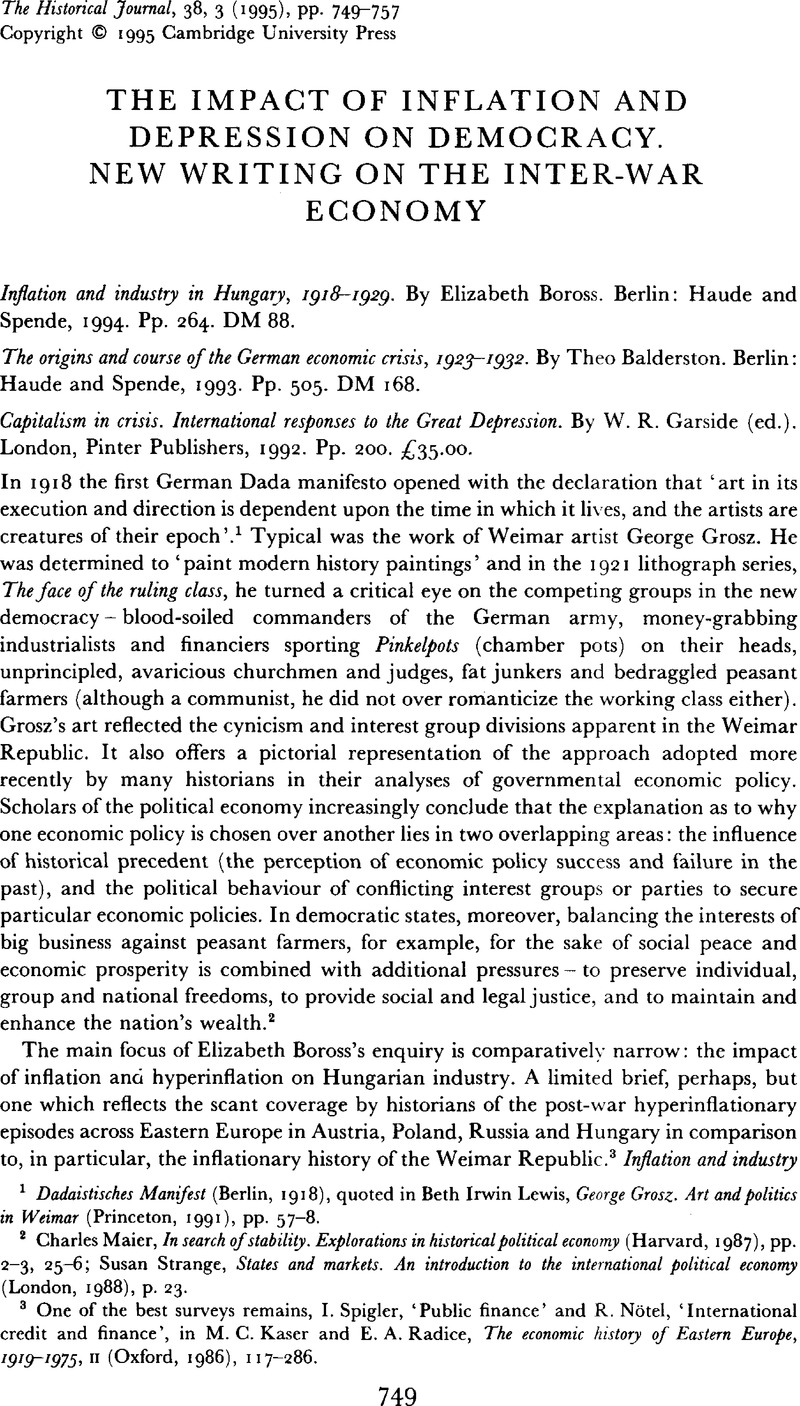Article contents
The impact of inflation and depression on democracy. new writing on the inter-war economy
Published online by Cambridge University Press: 11 February 2009
Abstract

- Type
- Review Articles
- Information
- Copyright
- Copyright © Cambridge University Press 1995
References
1 Dadaistisches Manifest (Berlin, 1918)Google Scholar, quoted in Beth, Irwin Lewis, George Grosz. Art and politics in Weimar (Princeton, 1991), pp. 57–8.Google Scholar
2 Charles, Maier, In search of stability. Explorations in historical political economy (Harvard, 1987), pp. 2–3, 25–6Google Scholar; Susan, Strange, States and markets. An introduction to the international political economy (London, 1988), p. 23.Google Scholar
3 One of the best surveys remains, Spigler, I., ‘Public finance’Google Scholar and Notel, R., ‘International credit and finance’Google Scholar, in Kaser, M. C. and Radice, E. A., The economic history of Eastern Europe, 1919–1975, II (Oxford, 1986), 117–286.Google Scholar
4 Boross, , Inflation and industry, p. 7.Google Scholar
5 Ibid. pp. 26–9.
6 Ibid. p. 49.
7 Matis, H., ‘Disintegration and multi-national enterprises in Central Europe during the post-war years, 1918–1923’, Alice, Teichova and Cottrell, P. J. (eds.), International business and central Europe, 1918–1939 (Leicester, 1983), p. 75.Google Scholar
8 Gerald, Feldman, The great disorder: politics, economics and society in the German inflation (Oxford, 1993)Google Scholar. The most positive account of Weimar's hyperinflation remains Carl-Ludwig, Holtfrerich, The German inflation. Causes and effects in international perspective (Berlin, 1986).Google Scholar
9 Estimates vary. F. B. Tipton and R. Aldrich estimate 80 per cent of the total population involved in agriculture, An economic and social history of Europe, 1989–1939 (London, 1987), p. 188Google Scholar; G. Ambrosius and W. Hubbard estimate 53 per cent in A social and economic history of twentieth century Europe (London, 1989), pp. 57–60Google Scholar; and the estimate is 48 per cent in Munting, R. and Holderness, B. A., Crisis, recovery and war. An economic history of continental Europe, 1918–1945 (London, 1991), p. 48.Google Scholar
10 Cottrell, P. J., ‘Commentary: Western capital and the commercial banks of East Central Europe’, in Alice, Teichova and Cottrell, P. J. (eds.), International business, p. 374.Google Scholar
11 Boross, , Inflation and industry, pp. 183–215.Google Scholar
12 Knut, Borchardt, ‘Noch einmal: Alternativen zu Brüning's Wirtschaftspolitik?’, Historische Zeitschrift, CCXXXVII (1983), 67–83Google Scholar; Harold, James, The German slump (Oxford, 1985).Google Scholar
13 See the detailed chronology of the bond market in Balderston, , Origins and course, pp. 203–11.Google Scholar
14 Ibid. p. vii.
15 Ibid. pp. 270–1, 329, 406.
16 Ibid. p. 407.
17 James, H., ‘Financial flows across frontiers in the Great Depression’, Economic History Review, XLV, 3 (1992), 601.Google Scholar
18 Balderston, , Origins and course, pp. 286–98, 407.Google Scholar
19 For a summary see, Carl-Ludwig, Holtfrerich, ‘Economic policy options and the end of the Weimar Republic’, in Ian, Kershaw (ed.), Weimar: why did German democracy fail? (London, 1990), p. 75Google Scholar. This essay also contains an excellent summary of the Borchardt thesis in English. Contrast with James' estimates of German worker productivity, The German slump, pp. 195–9.
20 Garside, , Capitalism in crisis, p. 2.Google Scholar
21 The consensus is reflected in Eichengreen, , ‘The Great Slump revisited’, p. 213.Google Scholar
22 For example, Williamson, P., National crisis and national government: British politics, the economy and the Empire, 1926–1932 (Cambridge, 1992).Google Scholar
23 Booth, , ‘The British reaction to the economic crisis’Google Scholar in Garside, , Capitalism in crisis, p. 41.Google Scholar
24 The importance of agriculture is acknowledged, although underplayed, in Anthony, Badger, The New Deal. The depression years, 1933–40 (London, 1989), pp. 149–163.Google Scholar
25 Fearon, , ‘Hoover, Roosevelt and American economic policy during the 1930s’Google Scholar, in Garside, , Capitalism in crisis, p. 141.Google Scholar
26 Eichengreen, B., ‘The origins and nature of the Great Slump revisited’, Economic History Review, XLV, 2 (1992), 229Google Scholar; Eichengreen, , Golden fetters. The gold standard and the Great Depression, 1919–1939 (Oxford, 1992), pp. 345–7.Google Scholar
27 Kenneth, Mouré, Managing the franc Poincaré: economic understanding and political constraint in French monetary policy, 1928–1936 (Cambridge, 1991).Google Scholar
28 Schwarz, , ‘Searching for recovery: unbalanced budgets, deflation and rearmament in France during the 1930s’Google Scholar, in Garside, , Capitalism in crisis, p. 112Google Scholar. For the British story see, Parker, R. A. C., ‘The pound sterling, the American Treasury and British preparations for war, 1938–39’, English Historical Review, XCVIII (1979).Google Scholar
29 Aldcroft, , ‘Depression and recovery: the Eastern European experience’Google Scholar, in Garside, , Capitalism in crisis, pp. 171–2.Google Scholar
30 Witness Martin Kitchen's comparative political history of the 1930s which contains very little reference to the economic context. See Kitchen, M., Europe between the wars. A political history (London, 1988).Google Scholar
- 1
- Cited by




